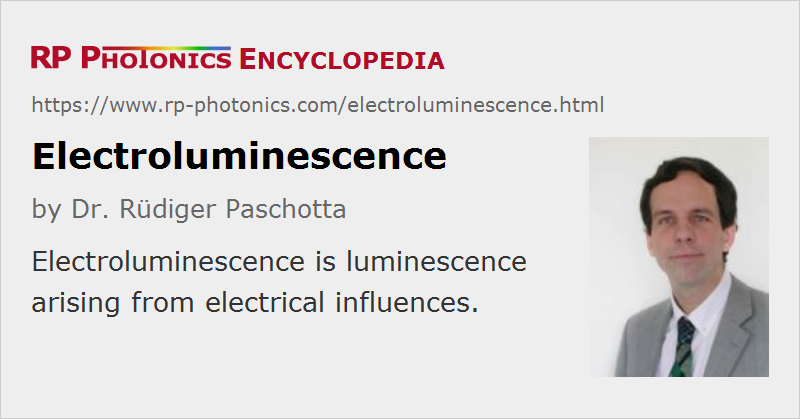Electroluminescence
Definition: luminescence arising from electrical influences
More general term: luminescence
German: Elektrolumineszenz
Category: physical foundations
How to cite the article; suggest additional literature
Author: Dr. Rüdiger Paschotta
Electroluminescence is a luminescence which arises from electrical influences. The technologically most important type of electroluminescence, as exploited in light-emitting diodes (LEDs), occurs in semiconductor p–n junctions, where an electric current can generate electron–hole pairs. Subsequent recombination of these pairs can lead to the emission of light. The quantum efficiency of such electroluminescence can be very high in direct band gap semiconductors with a low density of crystal defects: on average, nearly one photon is obtained for each electron–hole pair or for each electron sent into the device. The photon energy and thus the color of the emitted light are essentially determined by the bandgap energy of the material.
There are also electroluminescent displays, where a relatively high voltage is applied two electrodes between which there is some kind of organic or inorganic electroluminescent material (a phosphor). One electron, obtaining a much higher energy than in an LED, can lead to the emission of multiple photons. One electrode needs to be transparent or structured for extracting the generated light.
A different kind of electroluminescence, called cathodoluminescence, occurs when an electron beam hits some luminescent material (e.g. a phosphor). The impinging electrons allow the transfer of electrons from the valence band to the conduction band, i.e., the creation of electron–hole pairs. The subsequent photon emission works as described above.
Questions and Comments from Users
Here you can submit questions and comments. As far as they get accepted by the author, they will appear above this paragraph together with the author’s answer. The author will decide on acceptance based on certain criteria. Essentially, the issue must be of sufficiently broad interest.
Please do not enter personal data here; we would otherwise delete it soon. (See also our privacy declaration.) If you wish to receive personal feedback or consultancy from the author, please contact him e.g. via e-mail.
By submitting the information, you give your consent to the potential publication of your inputs on our website according to our rules. (If you later retract your consent, we will delete those inputs.) As your inputs are first reviewed by the author, they may be published with some delay.
See also: luminescence, light-emitting diodes
and other articles in the category physical foundations
 |





If you like this page, please share the link with your friends and colleagues, e.g. via social media:
These sharing buttons are implemented in a privacy-friendly way!